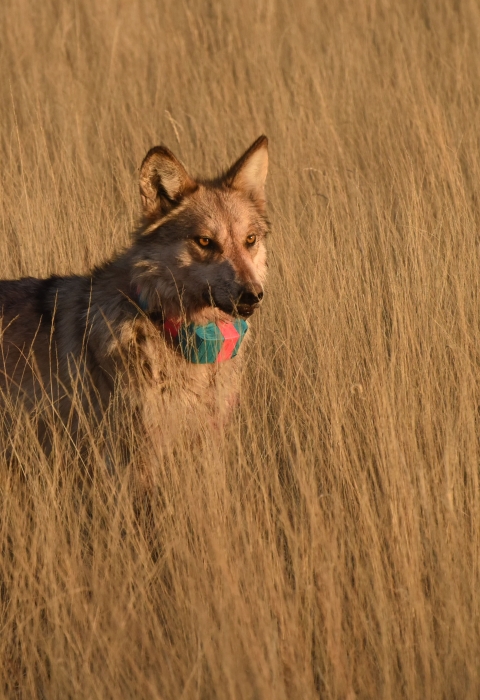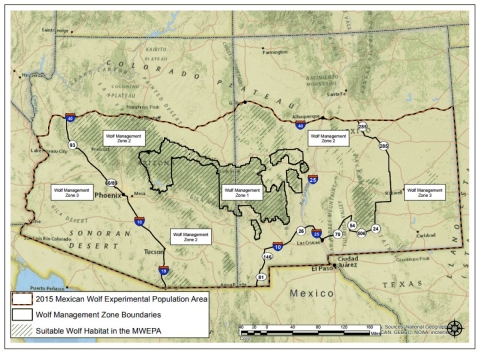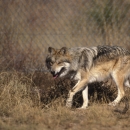Mexican wolves live in extended family groups, or packs, consisting of an adult mated pair and their offspring, often from several generations. They hunt cooperatively to bring down prey animals usually much larger than themselves. Native prey for Mexican wolves includes elk, mule deer, white-tailed deer, javelina, rabbits, and other small mammals. Mexican wolves are found in a variety of southwestern habitats; however, they are not low desert dwellers as once commonly believed. They prefer mountain woodlands, probably because of the favorable combination of cover, water, and available prey.
What is a Mexican Wolf?
General Description
The Mexican wolf (Canis lupus baileyi), is the smallest, southern-most occurring, rarest, and most genetically distinct subspecies of gray wolf in North America. Mexican wolves typically weigh 50 - 80 pounds and measure about 5 ½ feet from nose to tail, and stand 28 to 32 inches at the shoulder. They have a distinctive, richly colored coat of buff, gray, rust, and black, often with distinguishing facial patterns; solid black or white variations do not exist as with other North American gray wolves.
History
Historically, the core range of Mexican wolves occurred throughout mountainous regions from central Mexico, through southeastern Arizona, southern New Mexico, and southwestern Texas. More recent information obtained from examining historical wolf specimens however, suggests that Mexican wolves may have roamed farther north. The Mexican wolf was common throughout its core range through the mid-1800s. Towards the turn of the century, however, high cattle stocking rates and declining populations of native prey, such as deer and elk, caused many wolves to prey on livestock. This led to intensive efforts to eradicate Mexican wolves in the southwestern United States. By the mid-1900s, Mexican wolves had been effectively eliminated from the United States, and populations in Mexico were severely reduced. Following the passage of the Endangered Species Act in 1973, Mexican wolves were listed by the U.S. Fish and Wildlife Service as an endangered species in 1976, thereby prompting recovery efforts to save the species from extinction.
Pack Life
Mexican wolves have a complex social structure structure
Something temporarily or permanently constructed, built, or placed; and constructed of natural or manufactured parts including, but not limited to, a building, shed, cabin, porch, bridge, walkway, stair steps, sign, landing, platform, dock, rack, fence, telecommunication device, antennae, fish cleaning table, satellite dish/mount, or well head.
Learn more about structure and an intricate communication system that includes scent marking, body postures, and numerous vocalizations such as howling, barking, whining, and growling. They live in extended family groups, or packs, consisting of an adult mated pair and their offspring, often from several generations. The alpha pair is usually monogamous, and they typically are the only breeding animals in the pack. Although highly variable, a typical Mexican wolf pack might consist of 4 - 8 animals, with a territory encompassing up to several hundred square miles. Generally, they breed in February and give birth in April or early May to four to six pups after a 63-day gestation period.
Hunting
Mexican wolves hunt cooperatively to bring down prey animals usually much larger than themselves. This is accomplished primarily by chasing their prey often over large distances; however, hunting behavior and strategies likely vary depending on terrain and prey size and availability. Native prey for Mexican wolves includes elk, mule deer, white-tailed deer, javelina, rabbits, and other small mammals. Mexican wolves can and do occasionally kill livestock, particularly young animals. Mexican wolves also readily scavenge on carcasses of prey species.
Habitat
Mexican wolves are found in a variety of southwestern habitats; however, they are not low desert dwellers as once commonly believed. They prefer mountain woodlands, probably because of the favorable combination of cover, water, and available prey.


